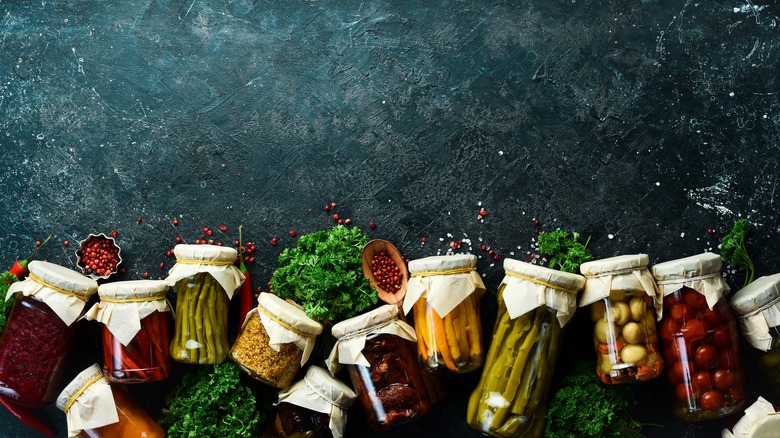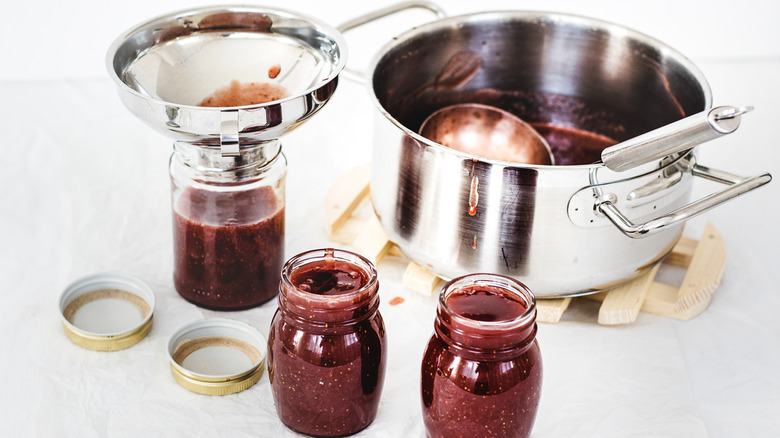Hot-Pack Canning Vs. Raw-Pack: What's The Difference?
Since 1795, when Napoleon first offered a reward to anyone who could come up with a feasible and safe method of preserving food, canning has developed a devout and hearty following (via USDA Agricultural Library). While industrial canning first took off in the United States in 1812, it's hard to deny the impact that canning fruits, vegetables, meat, and fish has had on American families throughout time. Especially crucial for pioneering and homesteading Americans in the expansion west and for soldiers across the country during the Civil War (via History of Antebellum American Agriculture), canning was once thought of as an act of practicality and frugality — but has become ironically trendy.
While it's possible to pickle just about anything – from green tomatoes to eggs – as a means of preservation, the realm of canning reaches even further, capturing the essence of summer's fruit harvest for the darker months ahead and creating ready-to-eat canned meat from a freshly-hunted deer or butchered cow.
When it comes to canning, there are two primary approaches: hot-pack and raw-pack canning. Let's take a look at the benefits of each.
Benefits of hot-pack canning
Generally considered by the United States Department of Agriculture (USDA) to be superior to raw-pack canning in retaining a higher quality of preserved food, hot-pack canning does come with some notable benefits, per Healthy Canning. The USDA says hot-packing distinctively requires bringing fresh food to a boiling point for two to five minutes, then immediately placing the boiled food into sterilized jars. Then, the jars must be sealed with a lid and boiled in a hot pot of water for a minimum of 10 minutes (via Eating Well). According to the USDA, the primary benefit of hot-pack canning is that it is the most efficient way to remove air from the jar.
The University of Alaska Fairbanks says the hot-pack method is also better for preserving acidic foods like pears, peaches, or pineapple than the raw-pack canning method. And, Clemson Cooperative Extension points out that hot-packing is a better means of quickly denaturing food enzymes, which reduces the likelihood that the food will spoil.
Hot-pack canning also decreases the volume of food, meaning canners can get away with using fewer jars to process the same amount of produce (via Healthy Canning).
When to raw-pack canned food
While there are ample benefits to the hot-pack canning method, there are times when raw-pack canning is a better option. True to its name, raw-pack canning, or cold-pack canning, involves packing raw fruits, veggies, or meat into sterilized jars and then topping them off with boiling water or syrup, via Delighted Cooking, and an optional portion of salt, and placing them in a pressure canner (via Clemson Cooperative Extension). The process of canning this way can take as little as 20 minutes or up to three hours, depending on the food, as Delighted Cooking explained.
Healthy Canning goes on to say that one advantage of the raw-packed method is that foods preserved in this way are less likely to lose their shape when preserved, making it a sufficient option for canning vegetables. However, jars of raw-packed food are more likely to become visually unappealing after a few months of storage due to water separation and floating insides — not to mention they might have a decreased nutrition value in the long-term than their hot-packed counterparts (via Healthy Canning).
Whichever way you choose to can, the benefits of this time-honored process span from reducing chemical preservatives in your diet to saving money on grocery bills. Whether you're interested in saving time up-front with the raw-pack method or securing longer-lasting, higher quality preserves through hot-packing, canning has a way of reminding us of our roots while opening up avenues for creative expression.


